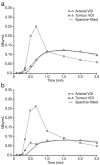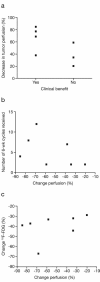Pharmacodynamic analysis of tumour perfusion assessed by 15O-water-PET imaging during treatment with sunitinib malate in patients with advanced malignancies
- PMID: 22682364
- PMCID: PMC3468361
- DOI: 10.1186/2191-219X-2-31
Pharmacodynamic analysis of tumour perfusion assessed by 15O-water-PET imaging during treatment with sunitinib malate in patients with advanced malignancies
Abstract
Background: We evaluated pharmacodynamic changes in tumour perfusion using positron emission tomography (PET) imaging with 15O-water to assess biological response to sunitinib, a multitargeted tyrosine kinase inhibitor.
Methods: Patients with advanced malignancies received sunitinib 50 mg/day orally, once daily for 4 weeks on treatment, followed by 2 weeks off treatment, in repeated 6-week cycles. Quantitative measurement of tumour perfusion was assessed using 15O-water-PET at baseline and after 2 weeks of treatment. At least one reference tumour lesion was included in the fields of view and assessed at both time points. Patients also underwent 18 F-fluorodeoxyglucose (FDG)-PET imaging at baseline and after 2 and 4 weeks of treatment. Radiological response of the reference tumour lesion and overall radiological response were assessed at week 12. Serum pharmacokinetic and biomarker analyses were also performed.
Results: Data were available for seven patients. Compared with baseline, all patients experienced a decrease in reference tumour blood flow ranging from 20 % to 85 % and also a reduction in the FDG standard uptake value ranging from 29 % to 67 %. Six patients experienced a partial metabolic response based on FDG-PET criteria. Four patients had stable disease defined by radiological response (Response Evaluation Criteria in Solid Tumors) lasting between 4 and 12 cycles. An association between perfusion change and clinical benefit, and biomarker levels including vascular endothelial growth factor was observed.
Conclusion: Administering sunitinib to patients with advanced malignancies is associated with early biological responses, including decreased blood flow in secondary tumour deposits.
Figures





Similar articles
-
Early prediction of response to sunitinib after imatinib failure by 18F-fluorodeoxyglucose positron emission tomography in patients with gastrointestinal stromal tumor.J Clin Oncol. 2009 Jan 20;27(3):439-45. doi: 10.1200/JCO.2008.17.2742. Epub 2008 Dec 8. J Clin Oncol. 2009. PMID: 19064982 Clinical Trial.
-
Combined positron emission tomography/computed tomography in sunitinib therapy assessment of patients with metastatic renal cell carcinoma.Clin Oncol (R Coll Radiol). 2011 Jun;23(5):339-43. doi: 10.1016/j.clon.2010.11.006. Epub 2010 Dec 4. Clin Oncol (R Coll Radiol). 2011. PMID: 21134733
-
FDG and FLT-PET for Early measurement of response to 37.5 mg daily sunitinib therapy in metastatic renal cell carcinoma.Cancer Imaging. 2015 Sep 3;15(1):15. doi: 10.1186/s40644-015-0049-x. Cancer Imaging. 2015. PMID: 26335224 Free PMC article. Clinical Trial.
-
FDG PET and FDG PET/CT in patients with gastrointestinal stromal tumours.Wien Med Wochenschr. 2012 Oct;162(19-20):423-9. doi: 10.1007/s10354-012-0131-y. Epub 2012 Aug 14. Wien Med Wochenschr. 2012. PMID: 22890522 Review.
-
18F-fluorodeoxyglucose positron emission tomography (18FDG-PET) for patients with biliary tract cancer: Systematic review and meta-analysis.J Hepatol. 2019 Jul;71(1):115-129. doi: 10.1016/j.jhep.2019.01.038. Epub 2019 Feb 21. J Hepatol. 2019. PMID: 30797051
Cited by
-
Whole-body parametric mapping of tumour perfusion in metastatic prostate cancer using long axial field-of-view [15O]H2O PET.Eur J Nucl Med Mol Imaging. 2024 Nov;51(13):4134-4140. doi: 10.1007/s00259-024-06799-3. Epub 2024 Jun 28. Eur J Nucl Med Mol Imaging. 2024. PMID: 38940842 Free PMC article.
-
Potential synergy between PSMA uptake and tumour blood flow for prediction of human prostate cancer aggressiveness.EJNMMI Res. 2021 Feb 9;11(1):12. doi: 10.1186/s13550-021-00757-y. EJNMMI Res. 2021. PMID: 33559792 Free PMC article.
-
Validation of [18F]FLT as a perfusion-independent imaging biomarker of tumour response in EGFR-mutated NSCLC patients undergoing treatment with an EGFR tyrosine kinase inhibitor.EJNMMI Res. 2018 Mar 27;8(1):22. doi: 10.1186/s13550-018-0376-6. EJNMMI Res. 2018. PMID: 29594931 Free PMC article.
-
Radiopharmaceuticals as probes to characterize tumour tissue.Eur J Nucl Med Mol Imaging. 2015 Apr;42(4):537-61. doi: 10.1007/s00259-014-2984-3. Epub 2015 Feb 3. Eur J Nucl Med Mol Imaging. 2015. PMID: 25647074 Review.
-
A review of harmonization strategies for quantitative PET.Ann Nucl Med. 2023 Feb;37(2):71-88. doi: 10.1007/s12149-022-01820-x. Epub 2023 Jan 6. Ann Nucl Med. 2023. PMID: 36607466 Free PMC article. Review.
References
LinkOut - more resources
Full Text Sources

